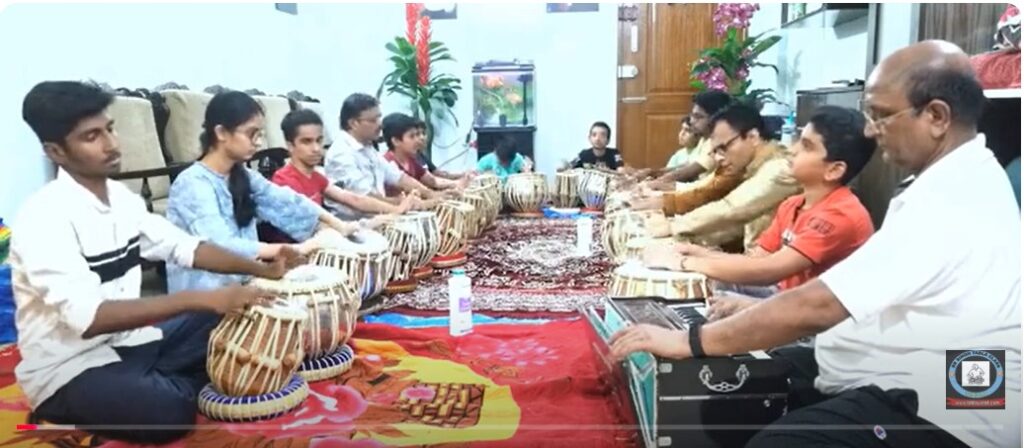SANGEET BHUSHAN PART-3 HAVE-4 TAAL, TEEN TAAL-16-LETTERS AND RUPAK TAAL -7 LETTERS-JHAPTAAL-10 LETTERS-AADA CHAAR TAAL-14 LETTERS. Sangeet Bhushan Part-3″ program. They should provide detailed information about the curriculum, requirements, and other relevant details.”Sangeet Bhushan Part 3 music course””Learn Sangeet Bhushan Part 3 online” “Sangeet Bhushan Part 3 certification”
Teen Taal is a prominent rhythmic cycle or taal (beat cycle) used in North Indian classical music, particularly in the Hindustani classical tradition. The term “Teen Taal” translates to “Three Beats,” and as the name suggests, it consists of 16 beats

Introducing Rupak Taal is a rhythmic cycle or taal used in North Indian classical music, specifically in the Hindustani classical tradition.
Rupak Taal is a rhythmic cycle or taal used in North Indian classical music, specifically in the Hindustani classical tradition. Rupak taal have 7 Letters-3- Division and Taali -2 and khali-(1) – Taali on (4-6) khali on (1)
Introducing the Jhap Taal, also known as Jhaptal or Jhaptaal, is a rhythmic cycle or taal used in North Indian classical music, particularly in the Hindustani classical tradition.
Jhap Taal, also known as Jhaptal or Jhaptaal, is a rhythmic cycle or taal used in North Indian classical music, particularly in the Hindustani classical tradition. Jhap Taal have 10-Letters and-4-Division Each division having 2-and-3-2and-3 Letters. Three Taali and one Khaali- Taali on-(1-3-8) and -6 is the khali .

Introducing the Aara Char Taal-14-Letters-Aara Char Taal” is a specific term used in a particular context,
Aara Char Taal” is a specific term used in a particular context, Aada Char Taal have 14 Letters -7- Division. Taali -4- and khaali-(3) Taali on (1-3-7-11) Khaali on (5-9-13)

https://www.youtube.com/@BhagawanSingh
The Sangeet Bhushan Part-3 is part of a structured certification program offered by institutions such as Pracheen Kala Kendra. It is designed to deepen a student’s understanding and proficiency in Indian classical music, including both theoretical knowledge and practical application. Here’s an overview of its features:
Curriculum Highlights:
- Rhythmic Cycles (Taal):
- Includes taals like Teen Taal (16 beats), Rupak Taal (7 beats), Jhap Taal (10 beats), and Aada Chaar Taal (14 beats). These are essential rhythmic frameworks in Hindustani classical musicTabla Nawaz AcademySaraswati Sangeet Sadhana.
- Theory Component:
- Covers advanced concepts such as scales (Saptak), Ragas, Thaats, and their classification into Poorvanga and Uttaranga categories. Theoretical understanding of instruments like Tanpura and their roles is also emphasizedSaraswati Sangeet Sadhana.
- Practical Component:
- Students are trained in performing small compositions or “Khyal” in specific ragas such as Bageshree, Bhairavi, and Pilu. They also learn to render compositions in different languages like Hindi and BengaliSaraswati Sangeet SadhanaUrbanPro.
- Examinations:
- The program involves both theoretical and practical assessments. Students must demonstrate mastery in taals and raga-based compositionsPracheen Kala Kendra.
Certification Pathway:
The Sangeet Bhushan certification is part of a larger academic structure:
- Prerequisite: Prarambhik (Beginner level)
- Next Levels: Sangeet Visharad (equivalent to a bachelor’s degree) and Sangeet Bhaskar (postgraduate level)UrbanPro.
Benefits of Enrollment:
- Provides a solid foundation for professional music careers.
- Equips learners with skills to perform and compose in classical styles.
- Acts as a stepping stone toward higher qualifications in musicTabla Nawaz AcademySaraswati Sangeet Sadhana.
If you’re interested in the Sangeet Bhushan Part-3 or similar programs, it’s offered by various music schools, including online options. The Pracheen Kala Kendra, Chandigarh, is a notable provider for such certifications

